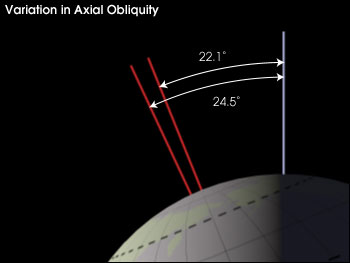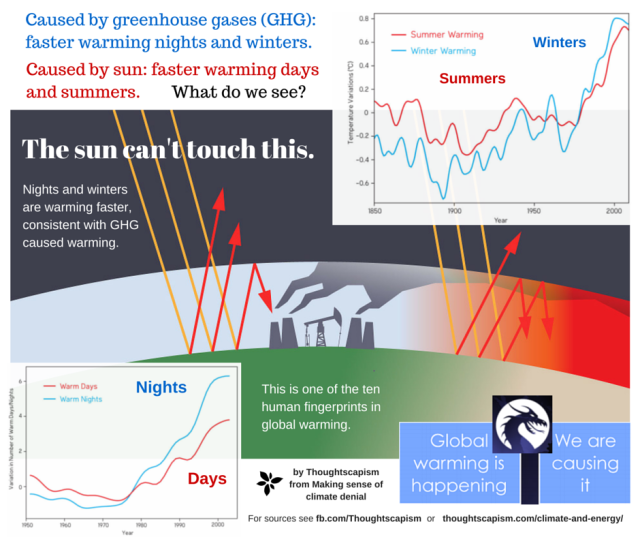The theory of Milankovitch cycles is named after Serbian astronomer and geophysicist, Milutin Milanković, who in the 1920s postulated three cyclical movement patterns related to Earth’s orbit and rotation and their resultant effects on the Earth’s climate. These cycles include axial tilt (obliquity), elliptical eccentricity, and axial precession. In aggregate, these cycles contribute to profound long term changes in earth’s climate via orbital forcing.
Axial Obliquity:
The Earth’s rotational axis is always tilted slightly; currently, its axis is about 23.4 degrees from the vertical. Alternatively, you could say that its equatorial plane is tilted about 23.4 degrees relative to its orbital plane. This tilt is responsible for Earth’s seasons. During the Northern Hemisphere (NH) summer, Earth is further away from the Sun than it is during the NH winter due to its slightly elliptical orbit, yet it receives more sunlight because it’s tilted towards the Sun. During this same time period, the Southern Hemisphere (SH) is tilted away from the Sun, which is why NH summer coincides with SH Winter and vice versa. Contrastingly, during the NH winter, the Earth is closer to the Sun, yet receives less sunlight because it’s tilted away from it. During that same period, the SH is tilted towards the Sun, and is thus experiencing summer.
However, that axial tilt slowly varies between about 22.1 degrees and 24.5 degrees over long quasi-periodic cycles of roughly 41,000 years. The last maximum is estimated to have occurred around 8,700 BCE, and the next minimum should occur roughly around the year 11,800 CE. A more exaggerated tilt corresponds to more severe seasons: warmer summers and colder winters. As you may have guessed, less exaggerated tilt corresponds to milder seasons: cooler summers and warmer winters. The latter phases can lead to increased glaciation. This is because cooler summers mean less ice loss per year, and warmer winters mean more precipitation (rain or snow) to build up ice sheets. Now, you might be wondering why exaggerated tilt wouldn’t build ice sheets with its extra cold winters, but remember that the freezing point of water at 1 ATM of pressure is still going to be 0 degrees Celsius. Reaching negative 50 degrees C in the winter isn’t likely to facilitate much greater glaciation than reaching negative 10 degrees C, and those extra cold winters would involve less precipitation. To add insult to injury, the extra hot summers would melt greater portions of the existing ice each year. That’s why smaller axial tilt values are thought to correspond to increased glaciation and larger tilt values to deglaciation. Moreover, greater surface areas of ice cover can function to resist warming via the ice-albedo feedback (or snow-albedo feedback), which I mentioned briefly in my article on how continental drift affects climate (here and here).

Axial Tilt (photo credit).
Axial Precession:
At any given obliquity, the direction of the earth’s rotational axis can “wobble” around the vertical in its own cycles (called precession) even while maintaining a more or less constant angle between the rotational axis and the vertical. This is caused by gravitational influences on the earth from the sun and moon. It takes roughly just under 26,000 years for the earth to complete an entire cycle of precession. Estimates differ from different sources, in part due to the fact that the rate of precession is not constant. This is also the reason earth’s axis points either towards Polaris or Vega as the “North Star” roughly every 13,000 years.
In the contrasting case (i.e. precession in the opposite phase of its current configuration), NH Winters would occur when Earth was furthest away from the sun and summers would occur when it was closest. That would mean extra hot summers, and thus more glacial melting. It would also mean extra cold winters, but those colder winters also correspond to less precipitation. That’s why our current precession should be more conducive to building the NH ice sheets, but the opposite is occurring due to reasons we’ll delve into soon enough. Again, loss of ice also means less help from the ice-albedo feedback effect, which could otherwise help resist further warming.
Although axial precession does not affect total annual insolation (the energy per unit area per unit time received by Earth in the form of EM radiation from the Sun integrated over a given time interval), it can have a profound effect on where and when that solar energy is distributed, and consequently on the formation or disintegration of ice sheets. Right now, the northern hemisphere (NH) is closer to the sun in the NH Winter and further away in the NH Summer. This makes NH Summers less hot and NH Winters less cold than would be the case if Earth were in the opposite phase in its precession cycle. Presumably, the warmer NH Winters should be conducive to more precipitation (snow fall), which would contribute to glaciation, whereas the moderate summers would be conducive to less glacial melting than if the precession were in the opposite configuration from its current phase.
Strictly speaking, the magnitude of these differences in seasonal effects depends on the eccentricity of Earth’s Elliptical path around the sun, (which is currently nearly circular), which means the difference in the earth’s radial distance from the sun doesn’t differ as greatly between its furthest and closest points in a given year. So, the climatological significance of axial precession depends both on axial tilt and orbital eccentricity (more on that later).
Moreover, neither axial tilt nor precession are known to affect the total amount of electromagnetic radiation energy coming in from the sun. Their immediate warming or cooling effects are only regional. BUT, regional warming can sometimes lead to global warming by altering ocean circulation patterns, redistributing heat throughout the oceans, and consequently causing the oceans to release stored CO2, by decreasing its solubility, which can drive additional warming via the greenhouse effect.
In part II, we’ll look at three other orbital cycles: orbital eccentricity, apsidal precession and orbital inclination. After that, we’ll look at their combined effects on climate in part III, and then discuss the limitations of our current knowledge by examining some unsolved problems regarding the relationship between these cycles and Earth’s glaciation cycles.
References:
Capitaine, N., Wallace, P. T., & Chapront, J. (2003). Expressions for IAU 2000 precession quantities. Astronomy & Astrophysics, 412(2), 567-586.
Hays, J. D., Imbrie, J., & Shackleton, N. J. (1976, December). Variations in the Earth’s orbit: pacemaker of the ice ages. American Association for the Advancement of Science.
Martin, P., Archer, D., & Lea, D. W. (2005). Role of deep sea temperature in the carbon cycle during the last glacial. Paleoceanography, 20(2).
Schmittner, A., & Galbraith, E. D. (2008). Glacial greenhouse-gas fluctuations controlled by ocean circulation changes. Nature, 456(7220), 373-376.
Skinner, L. C., Fallon, S., Waelbroeck, C., Michel, E., & Barker, S. (2010). Ventilation of the deep Southern Ocean and deglacial CO2 rise. Science,328(5982), 1147-1151.
Toggweiler, J. R., Russell, J. L., & Carson, S. R. (2006). Midlatitude westerlies, atmospheric CO2, and climate change during the ice ages.Paleoceanography, 21(2).




5 Comments
Milankovitch Cycles and Climate: Part II – Orbital Eccentricity, Apsidal Precession and Orbital Inclination – The Credible Hulk · October 11, 2016 at 10:24 am
[…] part I, we looked at some of the ways in which changes in axial obliquity and precession can affect the […]
Milankovitch Cycles and Climate: Part III – Putting it All Together – The Credible Hulk · October 13, 2016 at 11:07 pm
[…] parts I and II, we looked at axial obliquity, axial precession, apsidal precession, orbital eccentricity […]
The Solar Dynamo: The Physical Basis of the Solar Cycle and the Sun’s Magnetic Field – The Credible Hulk · January 14, 2017 at 1:52 am
[…] Milankovitch Cycles and Climate: Part I – Axial Tilt and Precession […]
Mean Field Theory and Solar Dynamo Modeling – The Credible Hulk · January 16, 2017 at 7:55 pm
[…] Milankovitch Cycles and Climate: Part I – Axial Tilt and Precession […]
No, Solar Variations Can’t Account for the Current Global Warming Trend. Here’s Why: – The Credible Hulk · January 17, 2017 at 5:08 pm
[…] Milankovitch Cycles and Climate: Part I – Axial Tilt and Precession […]
Comments are closed.